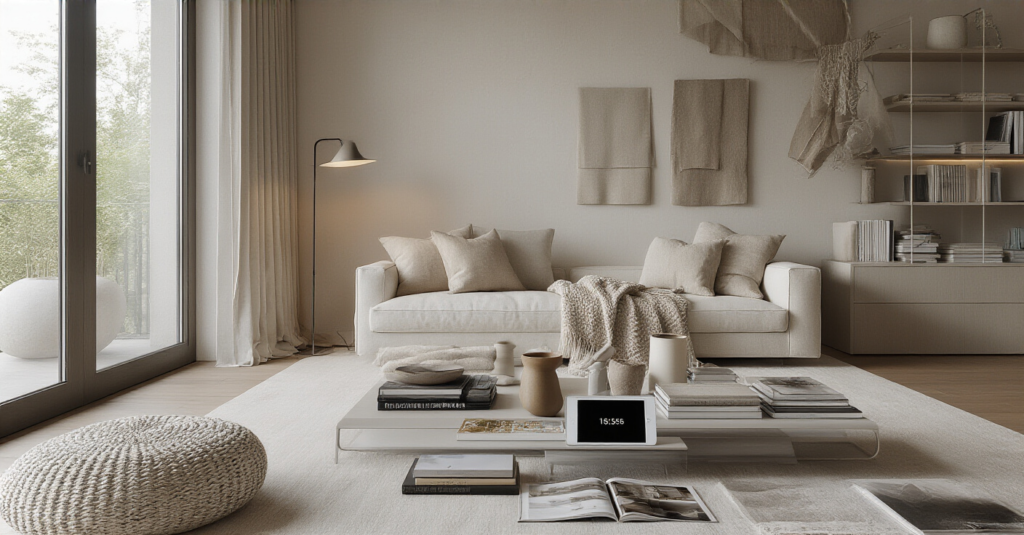Can we talk about my biggest pet peeve for a second? The idea of a “finished” living room. You know, the one that’s decorated once and then hermetically sealed, looking exactly the same in December as it does in July. My event planning background just screams at the thought of it! You wouldn’t use the same decor for a breezy summer wedding and a cozy winter gala, so why on earth do we expect our homes—the most important spaces in our lives—to be static, frozen-in-time museum pieces? That’s not a home; that’s a waiting room.
The real secret, the thing that separates a room that feels alive from one that just looks styled, is its ability to breathe and change with the rhythm of the year. People think this means a massive, expensive overhaul every three months. That’s the noise. What actually matters is creating a brilliant, versatile backdrop and then mastering the art of the quick-change. It’s about building a stage where the seasons are the star of the show.
I learned this the hard way with one of my first styling clients. Her home was magazine-perfect. Seriously, every object was placed with surgical precision. But when I visited in the fall, it felt cold and disconnected from the gorgeous, crisp world outside. It had zero soul. We spent one afternoon swapping a few key things—pillows, a throw, some branches in a vase—and the whole space just exhaled. It came to life.
So let’s call out the big BS lie right now: you do not need a massive budget or a degree in design to keep your home feeling fresh. You just need a game plan. These are the shortcuts and foundational truths I wish I’d known years ago, the stuff that makes seasonal decorating feel like a joyful celebration instead of a chore.
Foundational Planning & Strategic Assessment (Part 1)
Think of this part as building your perfect “capsule wardrobe” for your home. This isn’t the boring part; it’s the magic part. Getting this right means all the fun seasonal swaps you do later will look intentional and effortlessly chic, because you’ve created the perfect stage for them to shine on.
1. Define Your Personal Aesthetic and Lifestyle Needs
Before you even think about paint colors or furniture, you have to answer one question: What is the feeling you want your living room to have? Not just “modern” or “farmhouse,” but the actual vibe. Is it a cozy family hub for movie nights? A chic spot for cocktails with friends? A tranquil sanctuary for reading? Your room has a job to do, and your aesthetic is its uniform. Don’t get hung up on what’s trendy; focus on what feels like you.
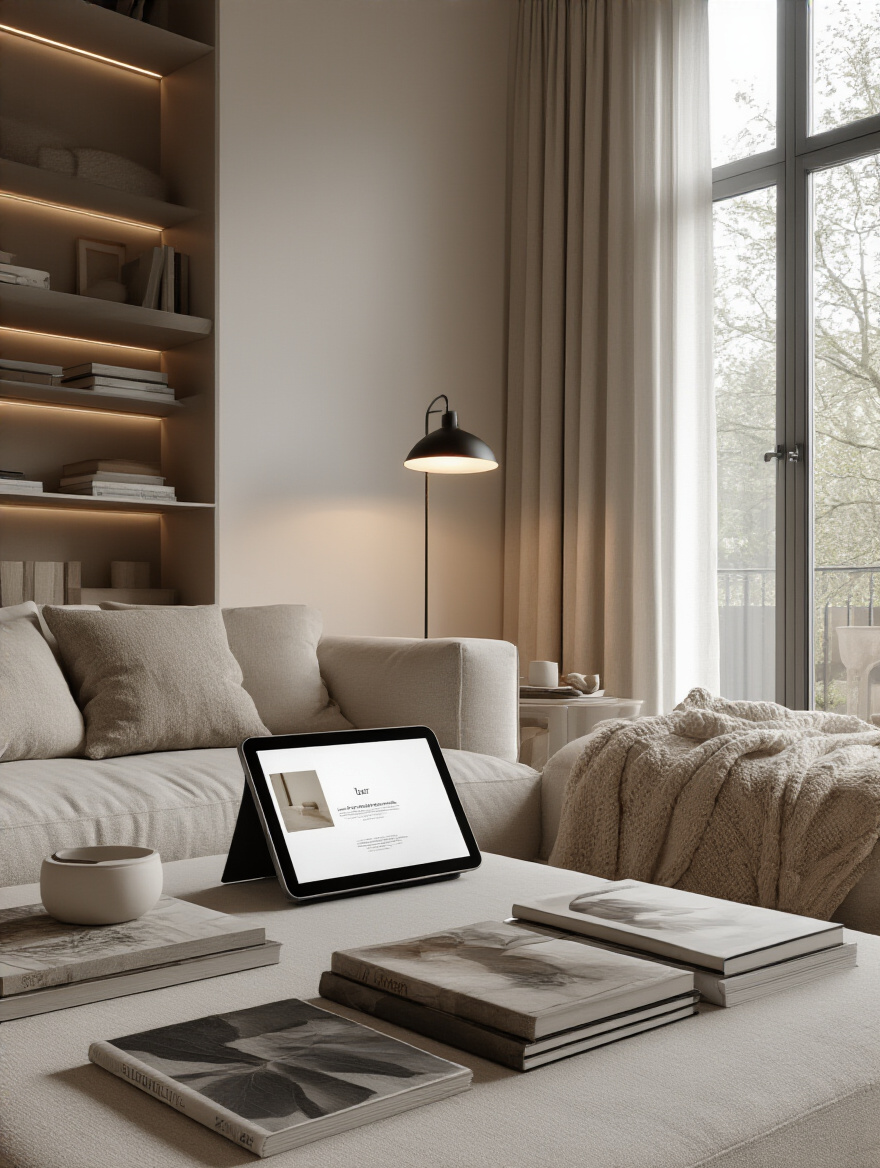
My trick is to create a “No” board on Pinterest right alongside your “Yes” board. Knowing what you actively dislike is sometimes even more clarifying than knowing what you like. This step is your compass. Without it, you’re just wandering through a home goods store, and that’s how you end up with a sofa you regret and a room that doesn’t feel like your own.
Now that you know the feeling you’re after, we need to make sure it actually fits into the physical space you have.
2. Accurately Map Your Living Room Layout and Flow
This sounds technical, but it’s really about mapping out the energy of the room. How do people move through it? Where does your eye naturally go when you walk in? That’s your focal point—maybe it’s a fireplace, a big window, or where the TV is. Arrange your main seating to honor that focal point, creating a natural invitation to sit down and relax.
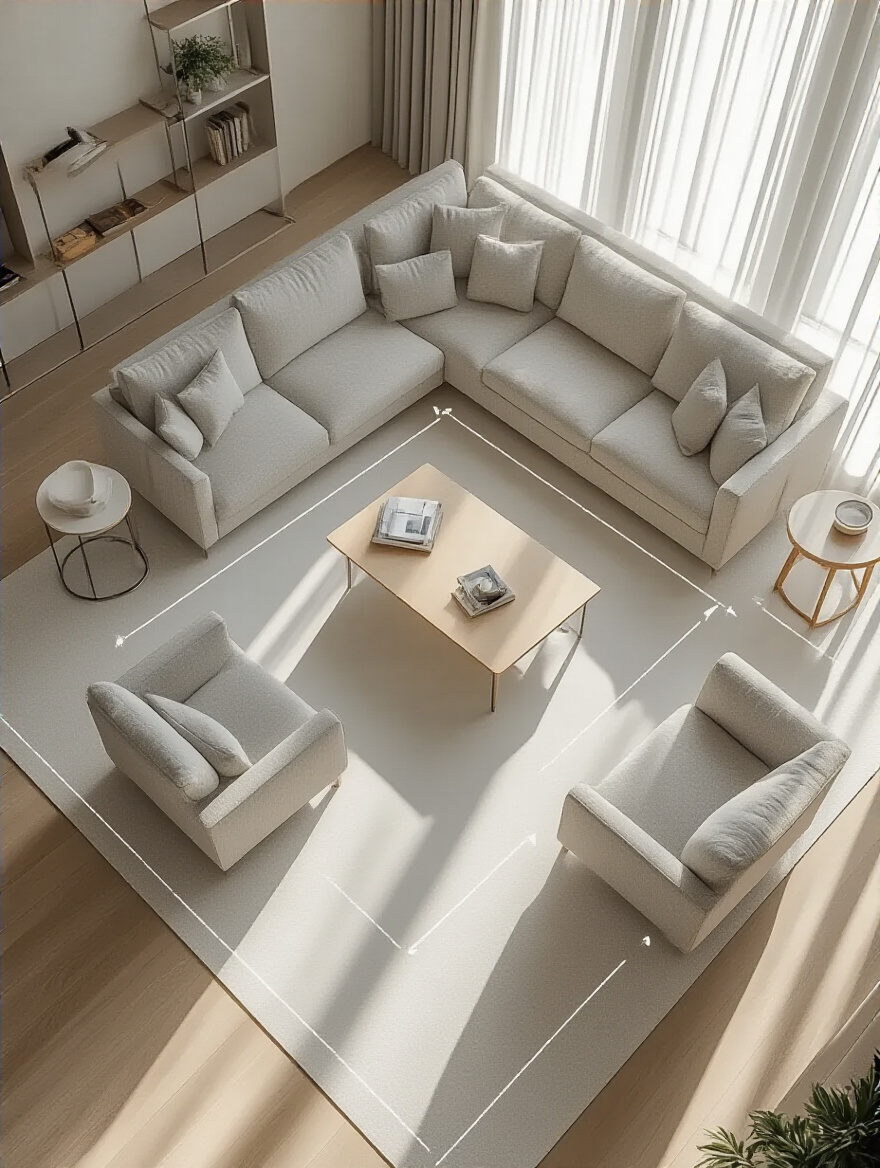
A great shortcut here is to use painter’s tape on the floor to outline where potential furniture will go. You can literally walk the paths and feel if it’s too crowded or awkward. A layout that doesn’t flow well is a constant, low-grade annoyance you don’t need in your life. A room that’s easy to move through just feels better, calmer, and more welcoming.
With the function and flow sorted, we can finally talk about the most powerful mood-setter of all: color.
3. Establish a Harmonious Color Palette and Mood
Your color palette is the backdrop for everything else. I always suggest thinking in layers. Start with a versatile, neutral base for the big, expensive things like your walls and sofa. Think warm whites, soft grays, or rich creamy tones. This is your canvas. It’s what will allow your seasonal decor to pop without having to repaint every few months.
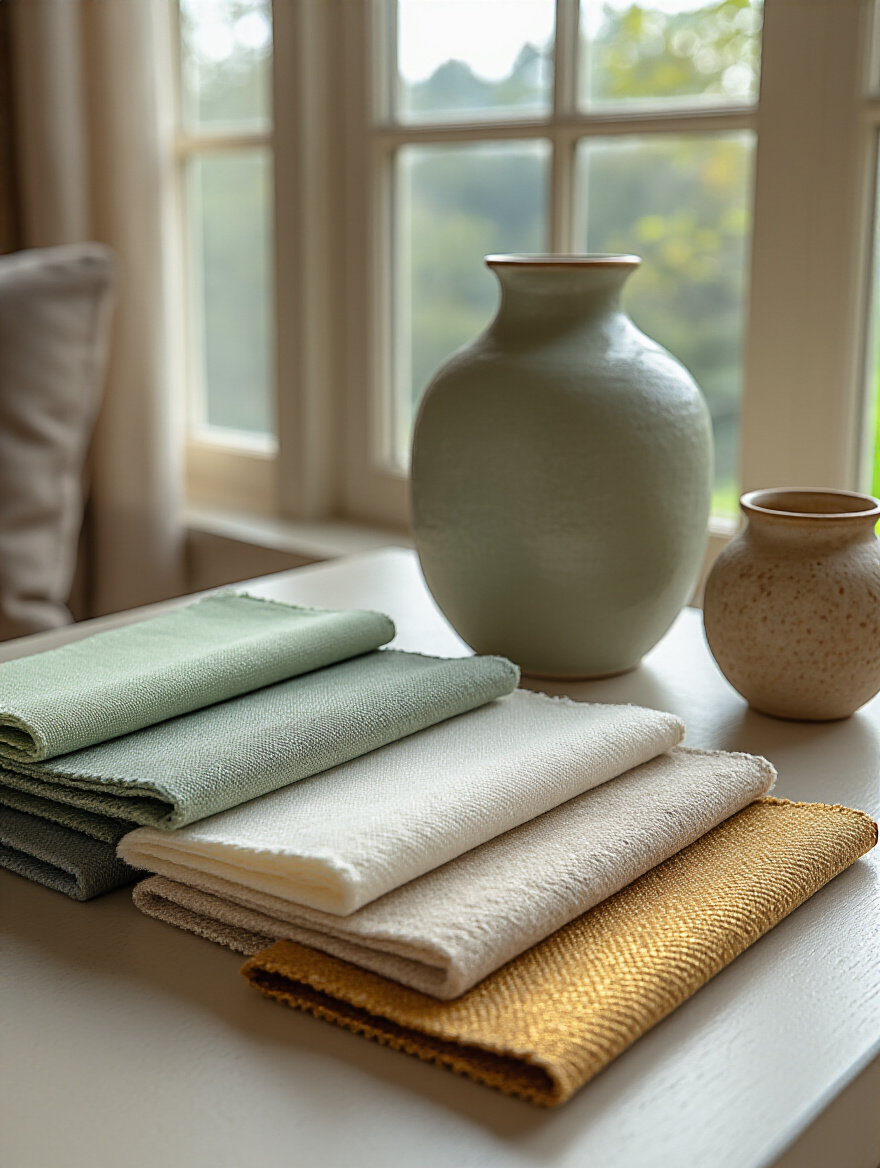
Then, choose your secondary and accent colors. These are for the things that are easy and affordable to swap out—pillows, throws, art, and accessories. A gorgeous olive green and burnt orange can warm up your neutral base for autumn, while swapping them for a breezy sky blue and crisp white makes the same room feel like a summer getaway. Following the 60-30-10 rule (60% dominant neutral, 30% secondary color, 10% accent) is a foolproof way to make it look balanced every time.
Let’s be real: none of this happens without a clear financial picture. It’s time to talk numbers so the fun doesn’t turn into stress.
4. Allocate a Realistic Budget for Your Decor Project
Budgeting isn’t about restriction; it’s about freedom. It’s what allows you to spend money on the things that make the biggest impact without feeling guilty or getting halfway through and running out of cash. The biggest mistake I see people make is only budgeting for the big furniture pieces. They completely forget about shipping, taxes, lamps, curtains, and that amazing piece of art that will tie it all together.
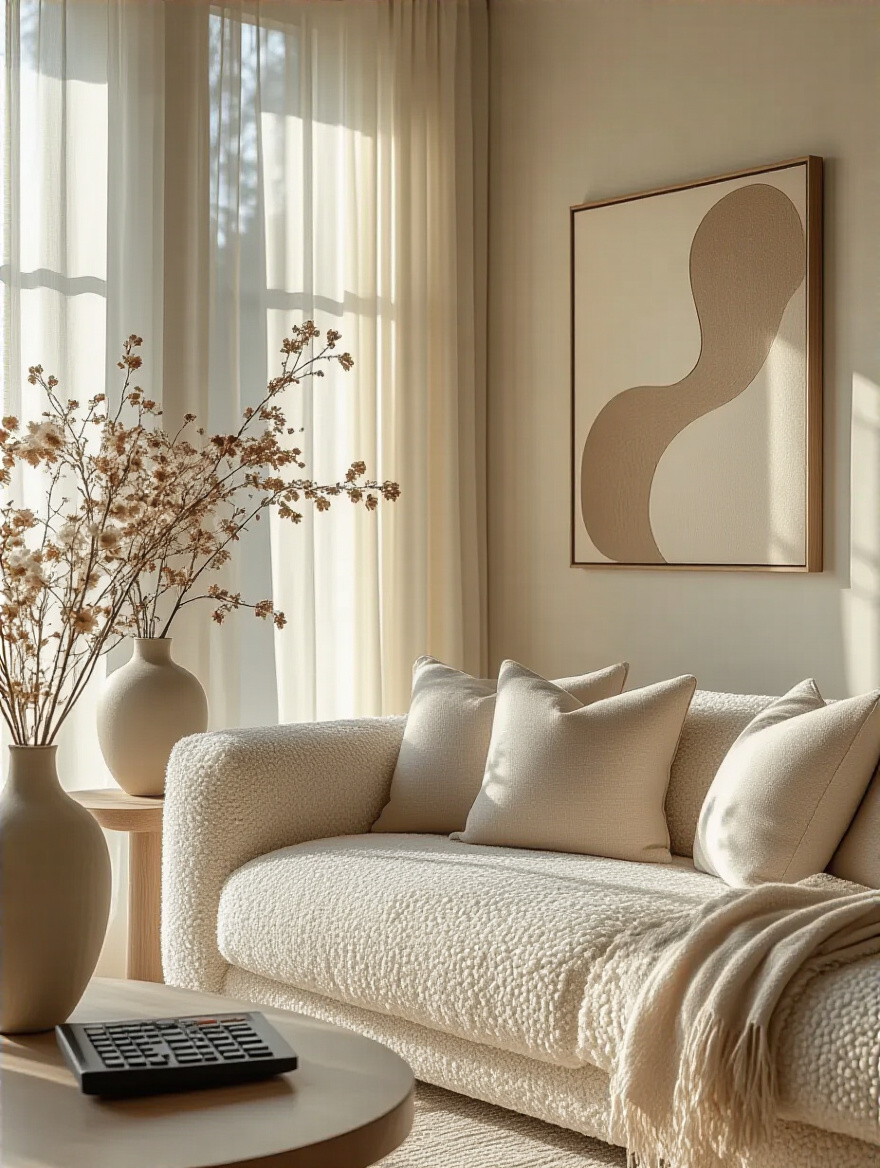
Here’s my rule: Always, always, always set aside a 15% contingency fund. You will use it. I promise. Something will be more expensive than you thought, or you’ll find the absolute perfect side table you didn’t plan for. Having that buffer is the difference between a joyful process and a stressful one. Prioritize your spending on the anchor pieces, like the sofa, and get creative with sourcing smaller items.
Once your vision is clear in your head, it’s time to make it tangible before you spend a dime.
5. Create a Visual Inspiration Board for Cohesion
A mood board is your project’s North Star. It’s a non-negotiable step that saves you from making mismatched, impulse purchases. This isn’t just about pinning pretty pictures; it’s about curating a real, tangible vision. Grab paint chips, fabric swatches from the store, a picture of the sofa you want, an image of a lamp—and put them all together on a physical board or a digital one using a tool like Canva.
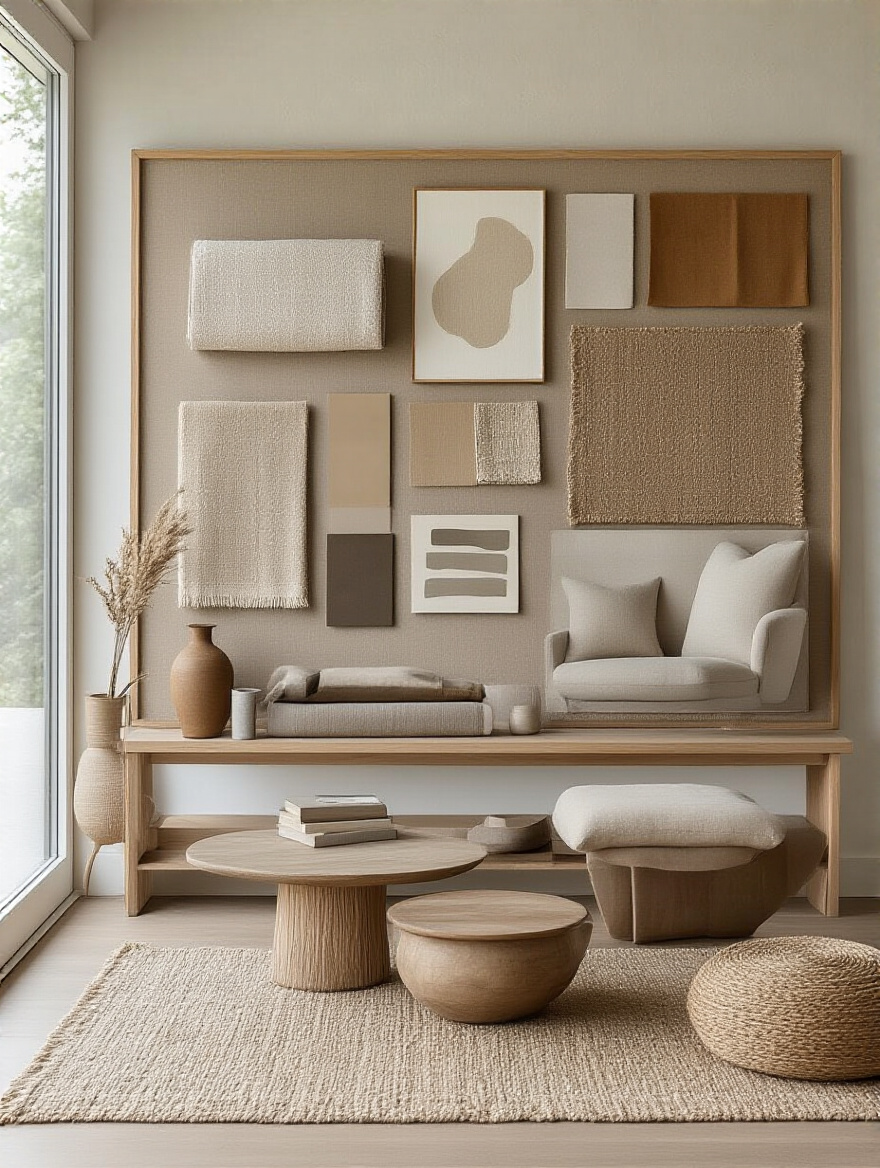
Seeing everything together is a game-changer. You’ll immediately notice if that rug you love clashes with the pillows or if the wood tone of the coffee table feels off. Your mood board is your gut-check. Refer back to it before every single purchase and ask, “Does this fit the vision?” It’s the single best way to ensure everything works together to create that perfect, cohesive feeling you’re dreaming of.
Core Furnishing & Essential Element Integration (Part 1)
Okay, now we’re getting into the big stuff—the anchors of your living room. These are the pieces that form the foundation of your space. Choosing wisely here is critical, because these elements will ground your room and serve as the perfect, reliable canvas for all your fun seasonal styling to come.
6. Select the Right Size and Style Sofa for Comfort and Scale
Your sofa isn’t just a piece of furniture; it’s the king or queen of your living room. It sets the tone for everything else. Choosing a neutral, classic style in a durable fabric is the smartest investment you can make for a seasonally-adaptable home. Think of it as your room’s “little black dress”—you can dress it up with cozy velvet pillows in the winter or light linen ones in the summer, and it will always look amazing.
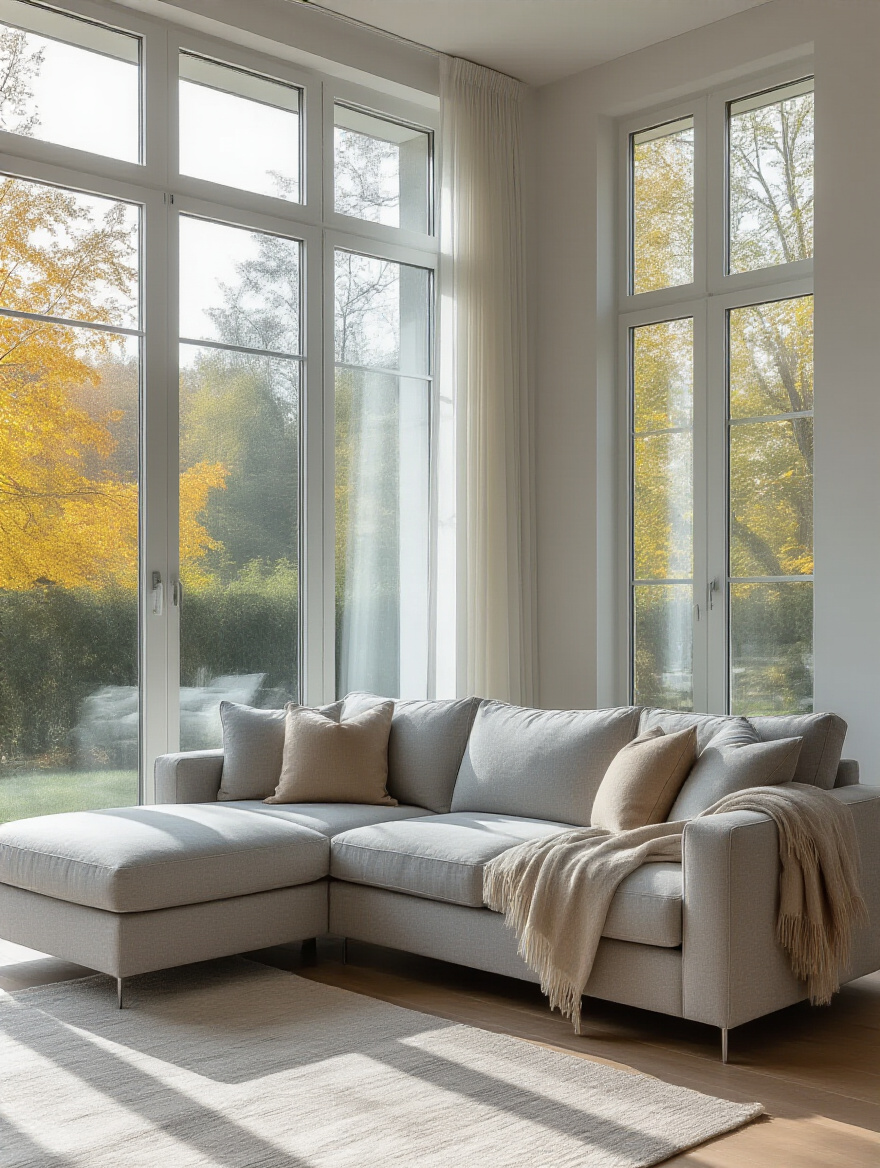
But please, for the love of all that is cozy, do not buy a sofa without sitting on it! And scale is everything. A massive, overstuffed sectional will devour a small room, while a dainty loveseat will look lost and lonely in a large one. Use that painter’s tape trick I mentioned to mock up the dimensions on your floor. It will save you from a world of hurt and expensive return shipping fees.
With the sofa chosen, you need something to ground it and define the whole conversation area.
7. Anchor Your Space with a Properly Sized Area Rug
Here’s one of the biggest rookie mistakes I see: the postage-stamp rug. You know the one, it’s a tiny little rectangle floating in the middle of the floor with all the furniture huddled around it like it’s a campfire. A rug is meant to be a foundation, not an island! It defines your seating area and makes the whole space feel more cohesive and expansive.
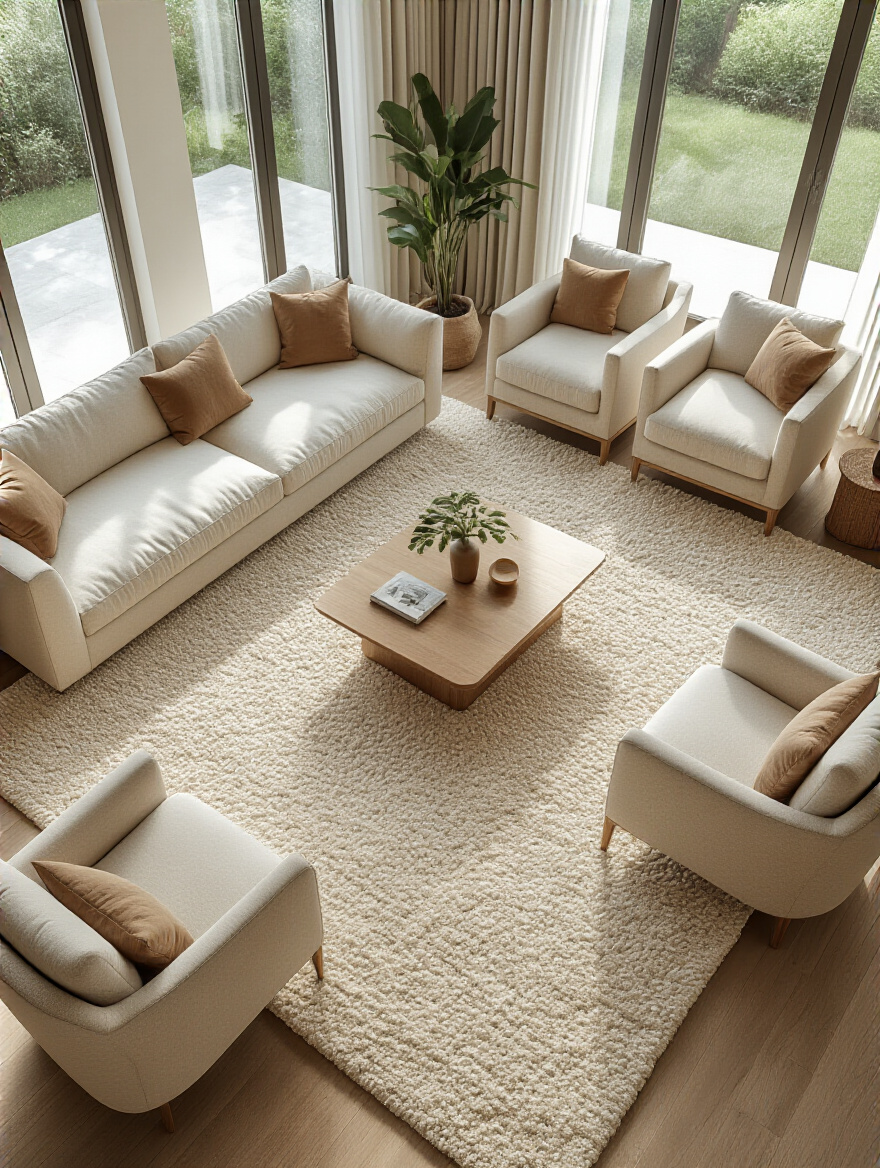
The rule of thumb is that at least the front legs of your sofa and any accent chairs should be sitting on the rug. This visually connects everything and makes the room feel unified and intentional. If you’re torn between two sizes, always go for the bigger one. It’s a bit more of an investment, but the impact it has on making your room look and feel more luxurious is absolutely worth it.
Now that your furniture is grounded, let’s talk about how we’re going to light it all up to create the perfect vibe for any occasion.
8. Implement Layered Lighting for Ambiance and Functionality
Relying on a single, harsh overhead light—what I call the “interrogation lamp”—is a crime against coziness. A beautifully designed room needs layers of light, just like a great outfit needs layers. You want to mix three types: ambient (the overall light from a ceiling fixture), task (focused light like a reading lamp), and accent (moody light from a table lamp or a picture light).
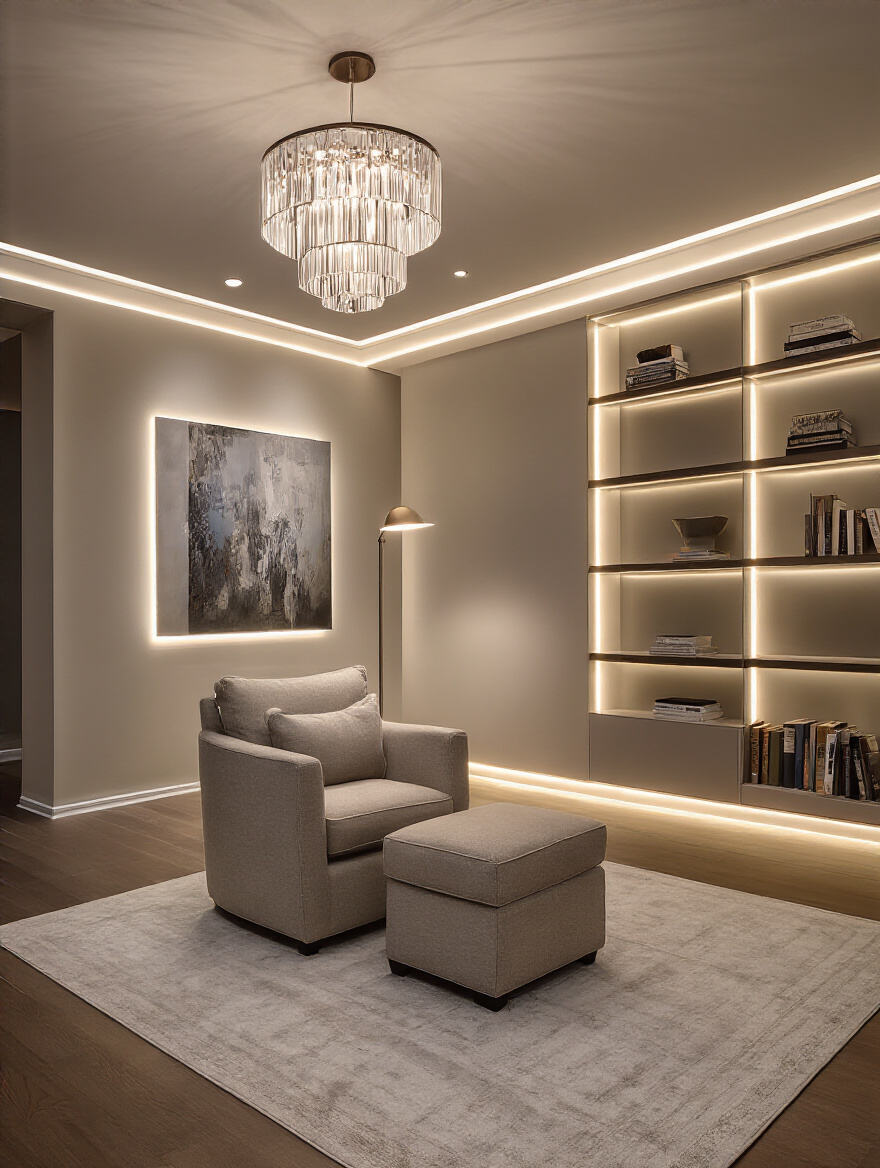
This is what gives you total control over the atmosphere. You can have it bright and energetic for a daytime gathering and then switch to soft, warm accent lighting for a relaxing evening. And here’s a non-negotiable tip: put everything on a dimmer switch. It is the single cheapest and most impactful upgrade you can make to a room. Being able to dial the light down is the secret to creating instant ambiance.
In today’s homes, especially if you’re short on space, your furniture needs to work as hard as you do.
9. Incorporate Multifunctional Furniture Pieces for Efficiency
This is where you get to be really smart and strategic. Every piece of furniture should earn its keep! A storage ottoman is the ultimate MVP—it’s a coffee table, extra seating, a footrest, and a secret hiding spot for blankets, toys, or magazines. It’s the perfect way to do a quick “seasonal swap” by just changing out the tray you have sitting on top.
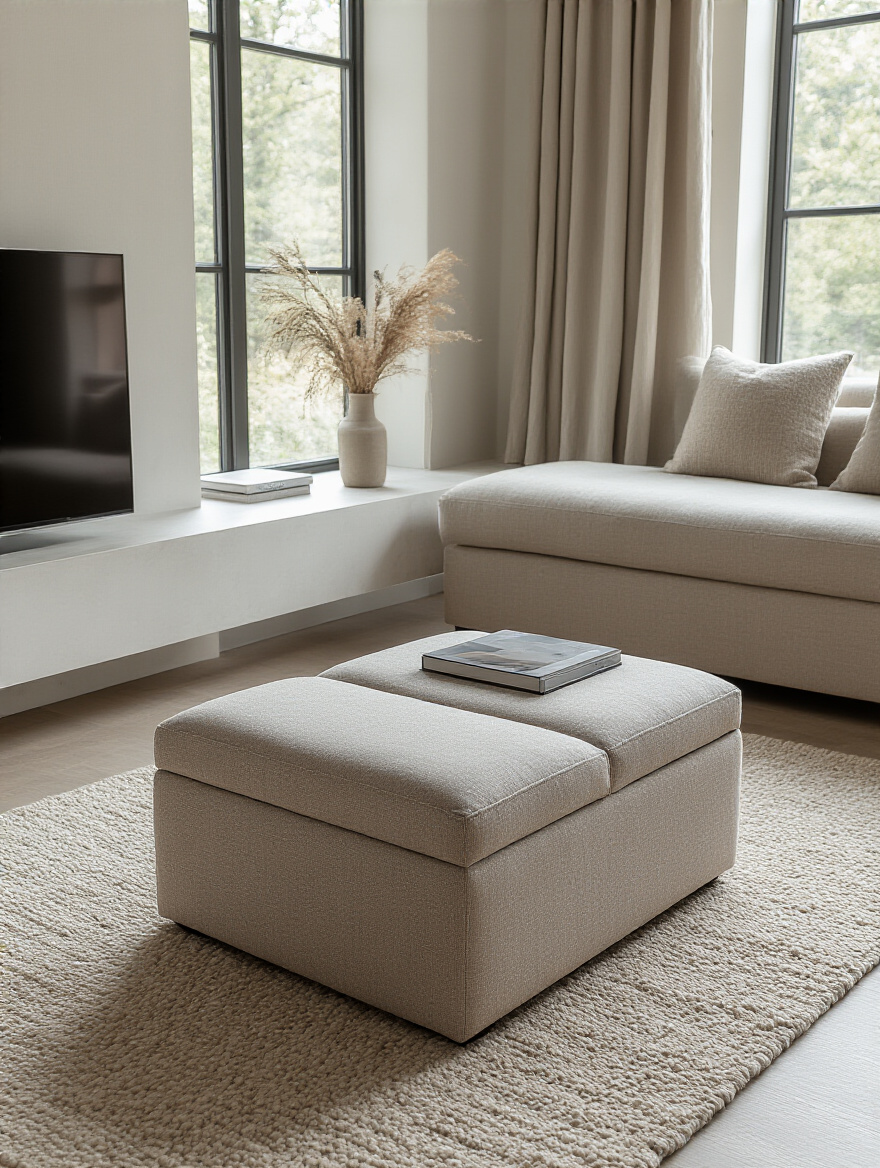
Think about nesting tables that can be pulled out for guests, or a media console with deep drawers instead of open shelves where clutter can accumulate. This isn’t about making your home feel like a Transformer; it’s about choosing clever pieces that maximize your space and minimize stress. Less visible clutter means more visual peace, which is always the goal.
Core Furnishing & Essential Element Integration (Part 2)
We’ve laid the groundwork with the major players. Now it’s time to fill in the gaps with the supporting cast—the essential pieces that add another layer of function and style, tying everything together into a space that’s as practical as it is beautiful.
10. Choose Complementary Coffee and Side Tables
Can we please declare the era of the matching “five-piece furniture set” officially over? Your living room shouldn’t look like it was picked directly off a showroom floor. It should feel collected over time. Your coffee and side tables are the perfect opportunity to mix materials and shapes to add character and depth.
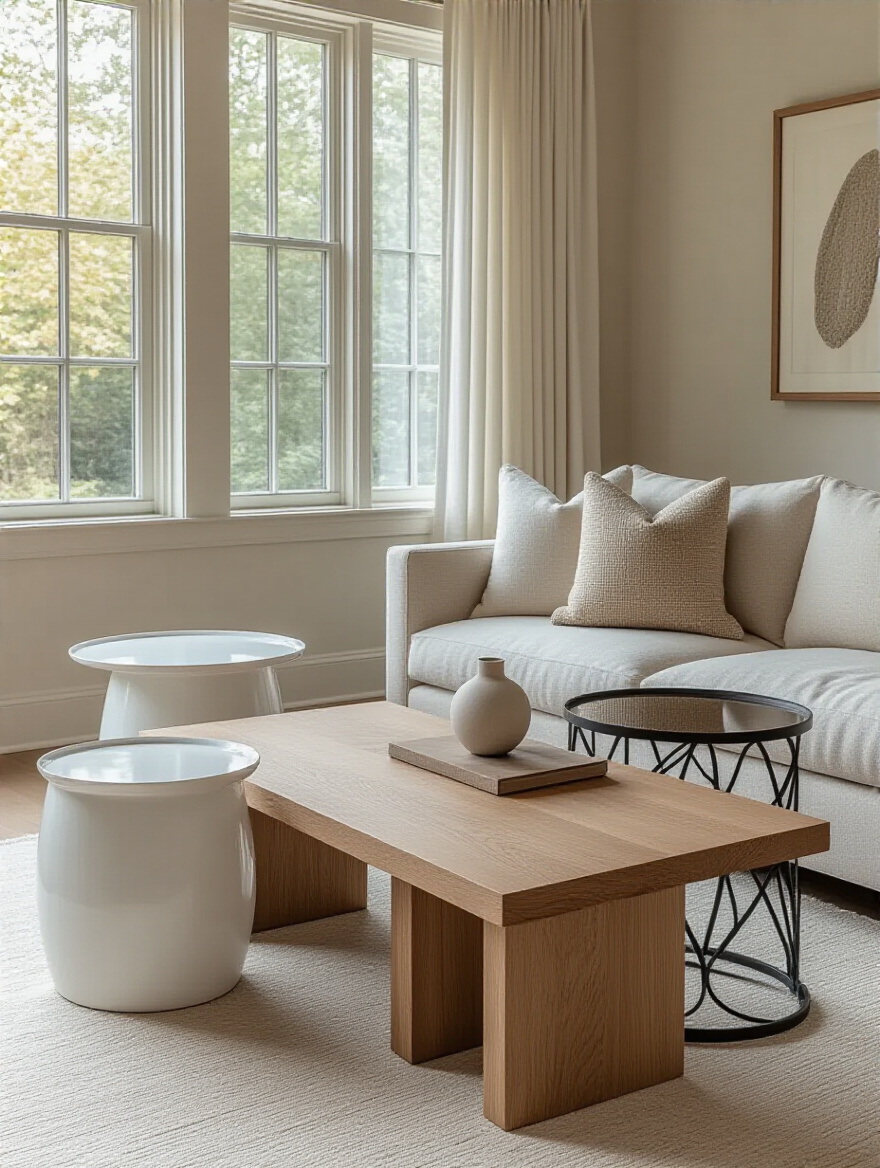
The key to making a mix feel cohesive rather than chaotic is to find a common thread. Maybe you pair a rustic wood coffee table with sleek metal side tables, but the black metal legs on the side tables echo the black hardware on your media console. Or perhaps a glass coffee table is paired with a marble side table, both sharing a sense of lightness and elegance. It’s this thoughtful mixing that makes a room feel layered and professionally designed.
Speaking of being practical, let’s tackle the beast that is everyday clutter once and for all.
11. Integrate Smart Storage Solutions to Minimize Clutter
A beautiful room can be instantly ruined by clutter. The secret to a tidy living room isn’t constantly cleaning; it’s having a designated home for everything. Smart storage is your best friend here, and it doesn’t have to be ugly plastic bins. Think of storage as part of your decor.
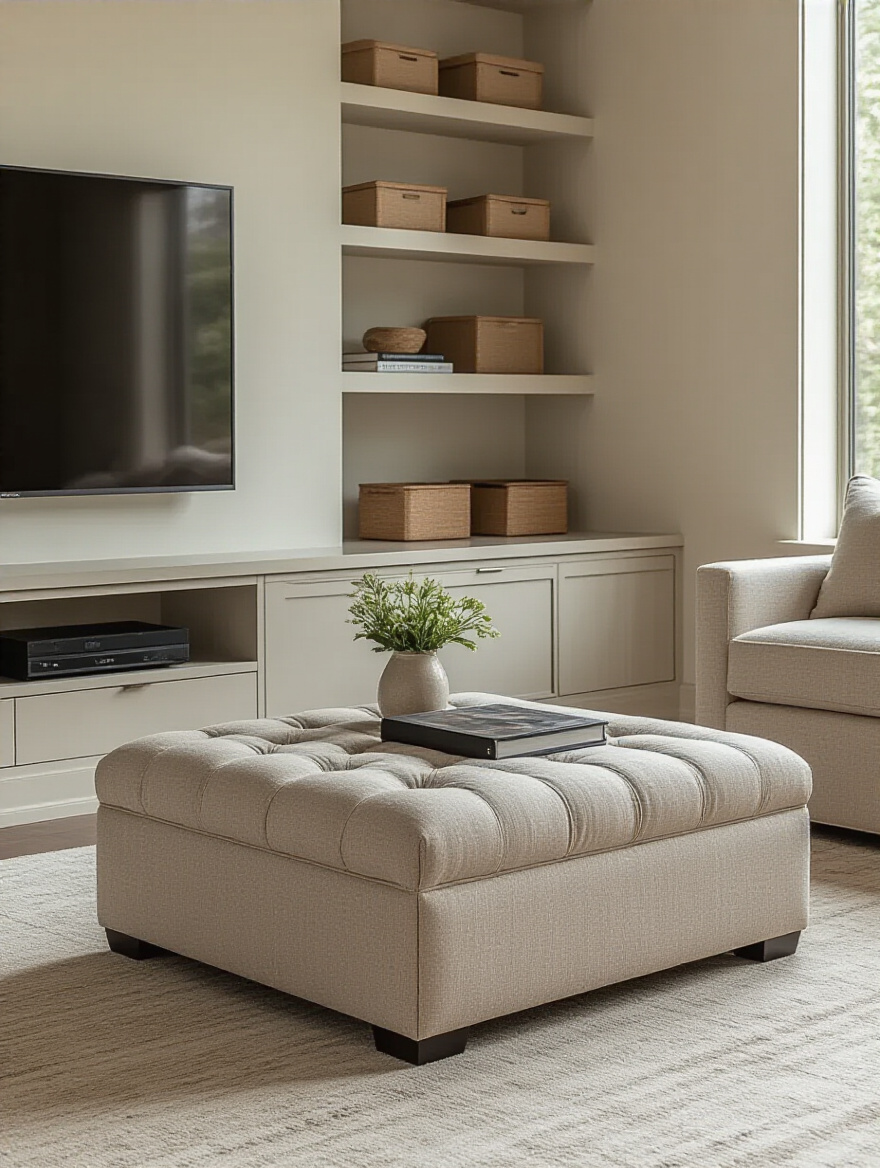
Choose a media unit with solid doors to hide all the wires and gaming consoles. Use beautiful woven baskets to hold extra throw blankets or kids’ toys. I love using decorative boxes on bookshelves to store smaller things like remotes, coasters, or charging cables. When your storage is beautiful, it just becomes part of the texture and style of your room, all while secretly keeping chaos at bay.
Styling, Texture & Personal Touch Enhancement (Part 1)
Alright, the stage is set! We have our foundational pieces in place. Now comes the really fun part—the styling! This is where you inject your personality, add layers of coziness, and truly make the space your own. This is how you tell your story.
12. Curate a Gallery Wall or Statement Art Piece
Bare walls are a cry for help! Art is the soul of a room, and you have two great ways to go. You can opt for one single, large-scale statement piece of art that acts as a powerful focal point, instantly defining the room’s color palette and mood. This is a bold, confident move that can make a huge impact.
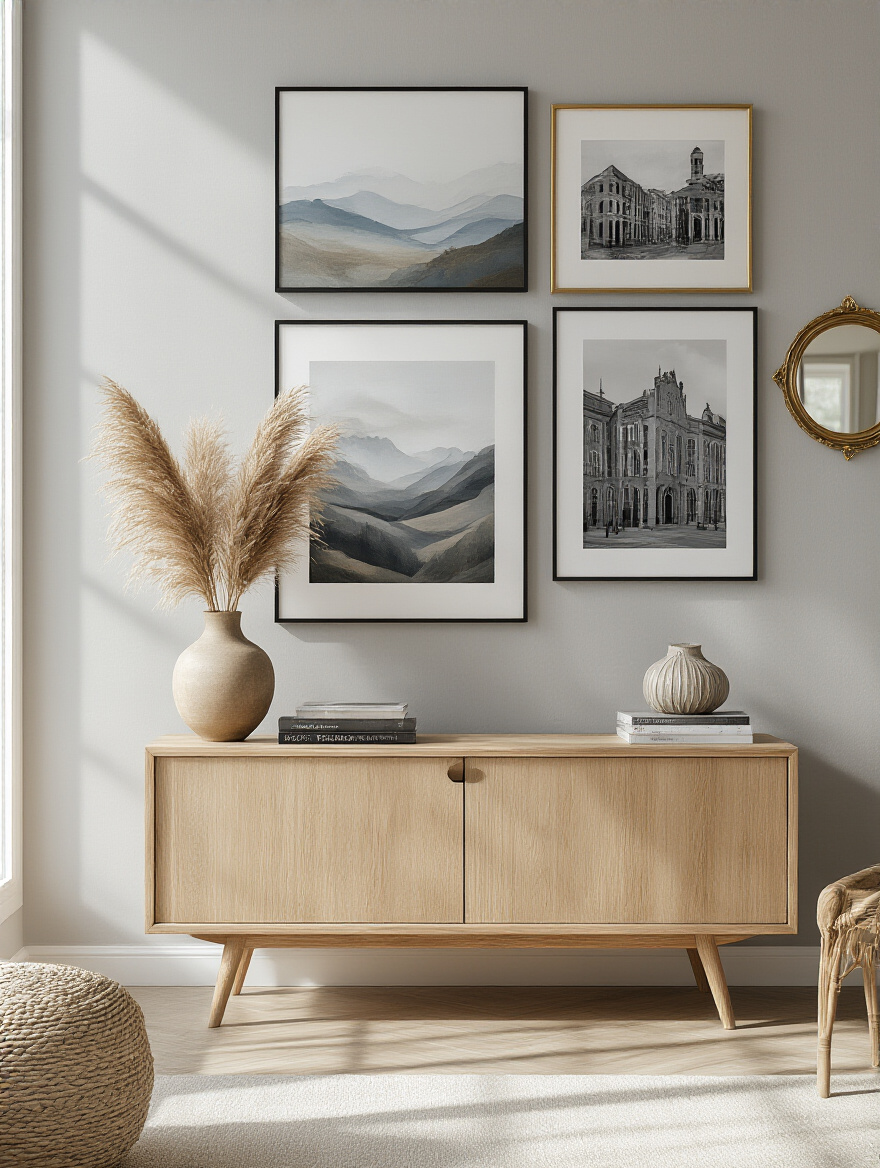
Or, you can create a gallery wall, which I absolutely adore because it’s a living, breathing part of your home. You can mix family photos, art prints, and even meaningful objects like concert ticket stubs or your kids’ drawings. My pro tip? Start with the largest piece in the center or slightly off-center and build out from there. And don’t be afraid to swap pieces out seasonally! A gallery wall is a story, and stories can change.
Art brings in the color and personality; next, we need to bring in the irresistible urge to curl up and get comfortable.
13. Layer Textiles with Throws, Pillows, and Curtains
This is my absolute favorite trick in the book and the easiest way to do a seasonal refresh. Layering textiles—pillows, throws, curtains, rugs—is what makes a room feel warm, inviting, and finished. It’s like adding jewelry to an outfit. A sofa without pillows and a throw just looks naked and sad.
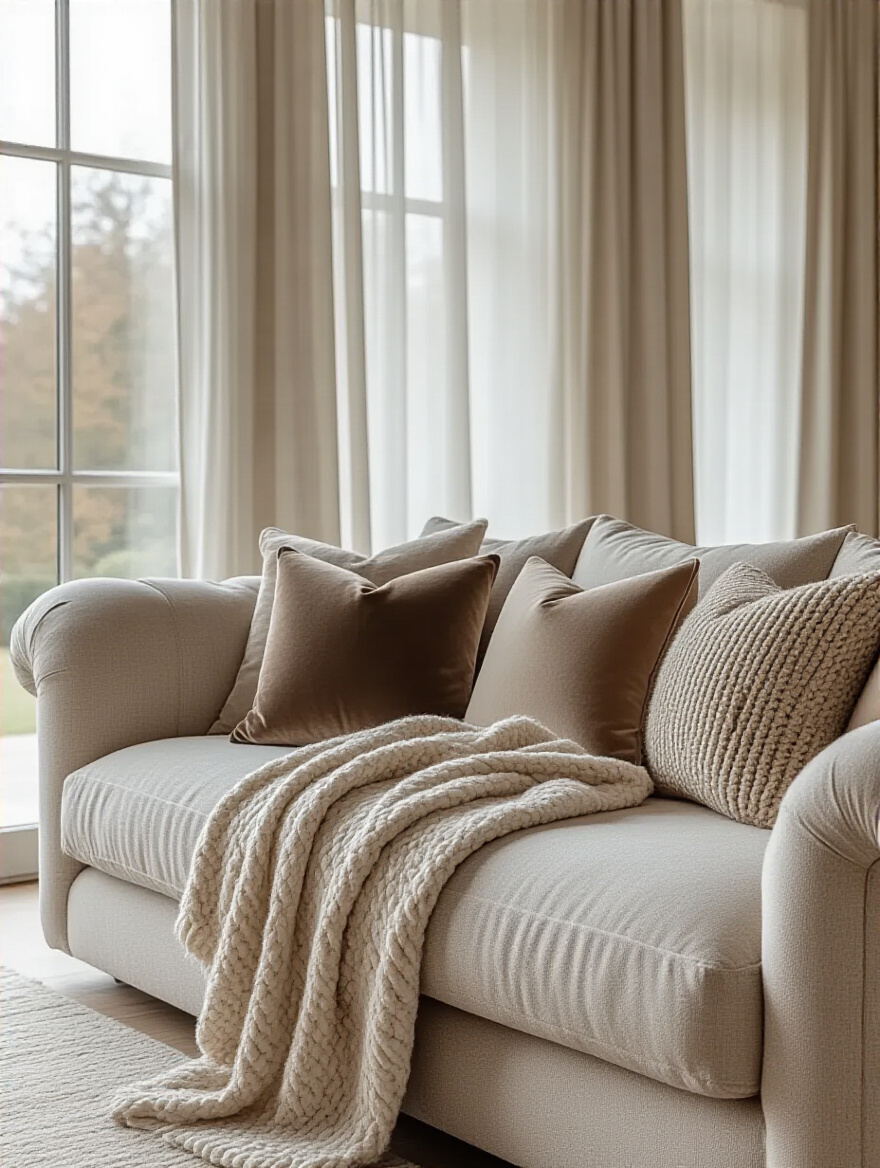
For an instant seasonal update, this is your go-to move. In the fall and winter, bring in chunky knits, faux fur, and rich velvet in deep, warm colors. Then, come spring and summer, swap them out for lightweight linen and crisp cotton in brighter, airier hues. It’s a 15-minute change that can completely transform the feeling of your entire room for less than the cost of a can of paint.
Now, let’s add something with a little life to it—literally.
14. Introduce Greenery with Thoughtfully Placed Houseplants
Nothing breathes life into a room quite like a bit of greenery. Plants add an organic, sculptural element that softens all the hard lines of your furniture and decor. They make a space feel healthier, more vibrant, and more connected to the outdoors. A tall fiddle-leaf fig in a corner can add drama and height, while a trailing pothos on a bookshelf can add a lovely, cascading sense of movement.
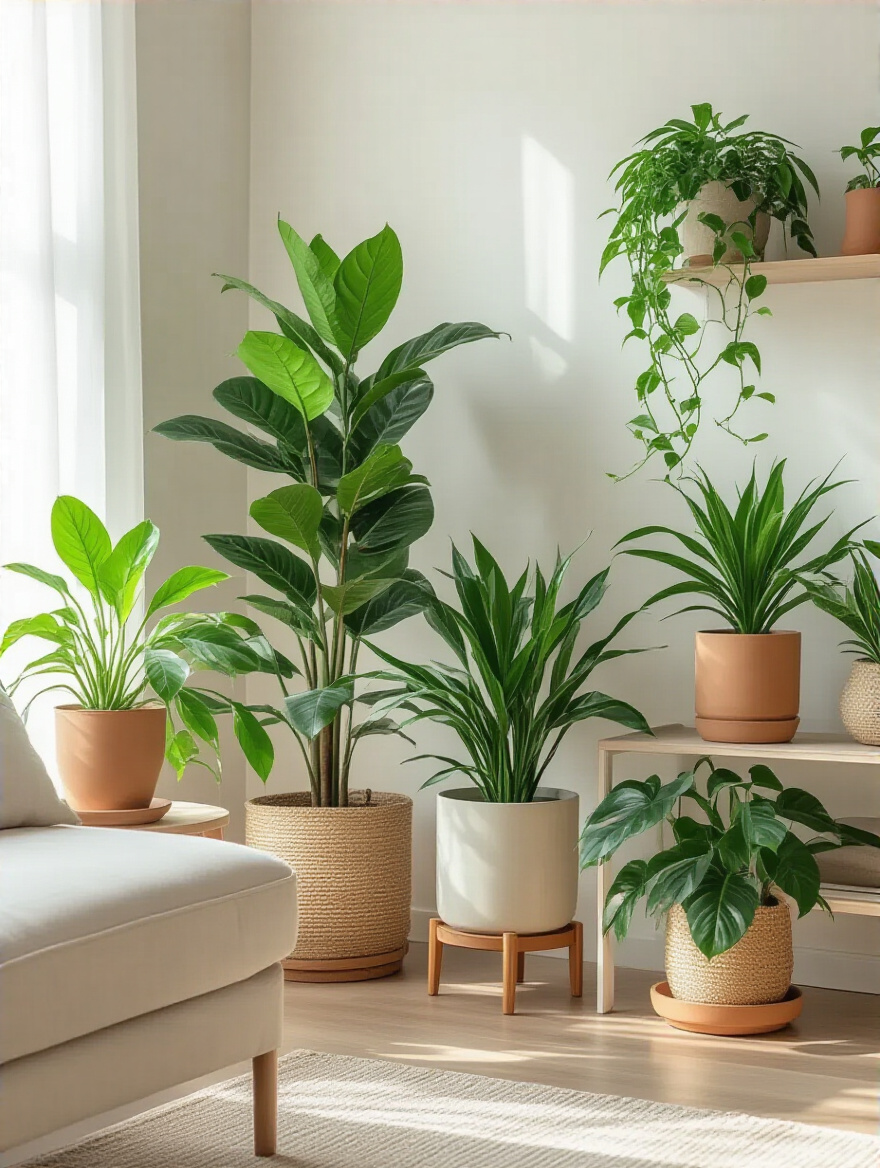
And let’s be honest, not everyone is a plant whisperer. I have killed my fair share! If you don’t have a green thumb, do not despair. The quality of faux plants today is absolutely incredible. Seriously, you have to touch them to know they’re not real. So whether it’s real or faux, adding that pop of green is a non-negotiable for a room that feels truly alive.
Your home should be a reflection of your life and your journey. Let’s make sure we put that story on display.
15. Arrange Decorative Objects and Collectibles Strategically
This is about turning your “stuff” into curated “collections.” Instead of scattering your treasured objects randomly around the room, group them together to create little stories, or what designers call “vignettes.” A stack of your favorite books on the coffee table topped with a candle and a small souvenir from a trip tells a much more interesting story than if those items were placed separately.
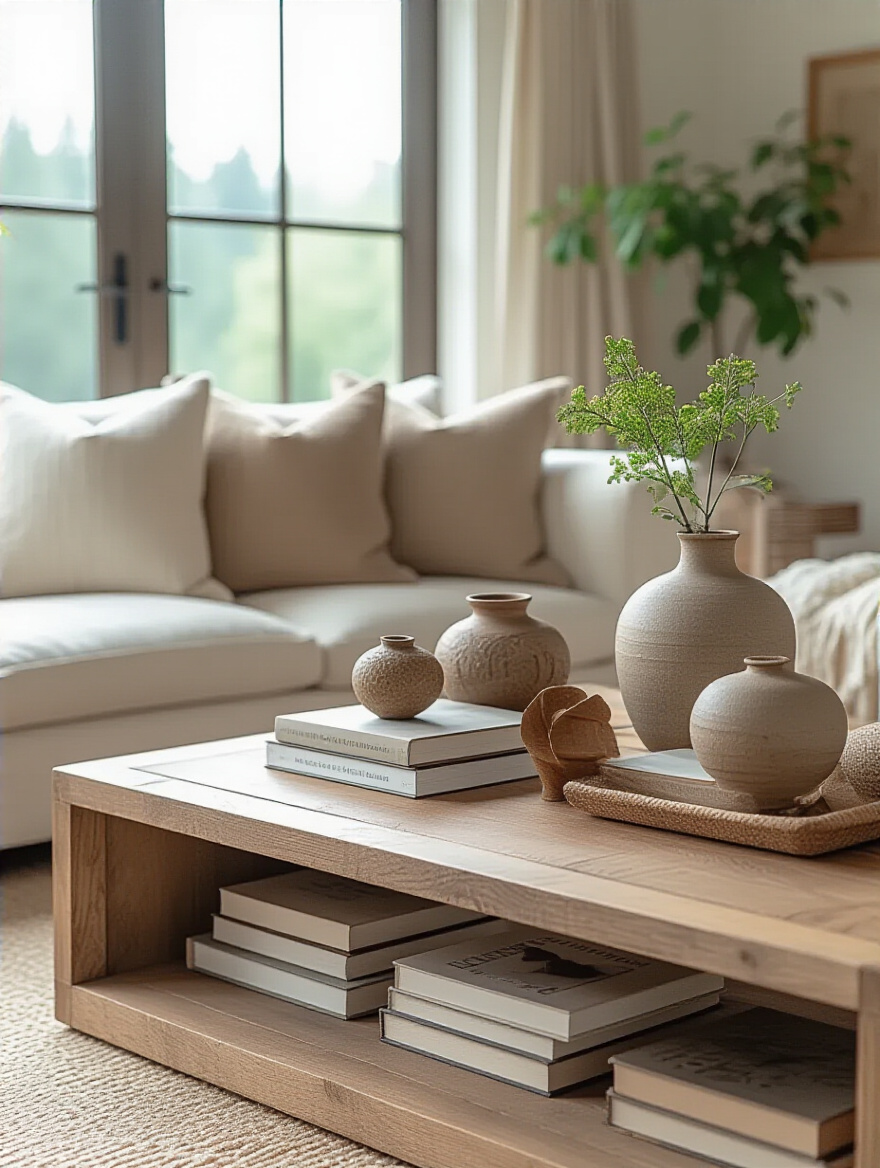
A classic designer trick is to group things in odd numbers—threes and fives are particularly pleasing to the eye. Vary the height and texture within your grouping to keep it interesting. And remember to use trays! A simple tray can corral a collection of small items on a coffee table or ottoman, instantly making them feel organized and intentional instead of cluttered.
Styling, Texture & Personal Touch Enhancement (Part 2)
We’ve added the layers and personal stories, but there’s one more styling trick that’s pure magic. This is a designer secret weapon that can fundamentally change the feel of a room without adding a single piece of furniture.
16. Use Mirrors to Enhance Light and Expand Perception of Space
Mirrors are the miracle workers of interior styling. They are absolute game-changers, especially for smaller or darker rooms. A large mirror placed directly across from a window will grab all that natural light and bounce it all around the space, making it feel instantly brighter and more open. It’s like adding a whole new window for a fraction of the cost.
Beyond just amplifying light, a mirror creates the illusion of depth, tricking the eye into thinking the room is bigger than it is. It’s the oldest trick in the book for a reason—it works! Don’t just think of a mirror as a functional object for checking your reflection. Think of it as reflective art that adds light, sparkle, and a sense of expansiveness to your living room.
Refinement, Adaptability & Advanced Techniques
You’ve got the foundations and the styling down pat. Now we’re going to level up. These are the advanced techniques that take your living room from “nicely decorated” to “effortlessly curated,” creating a space that is truly dynamic, deeply personal, and designed for living.
17. Master the Art of Mixing Different Decor Styles
This is how you get a home that looks uniquely yours and not like a page from a catalog. The most interesting and soulful rooms are never just one style. They are a thoughtful blend of different aesthetics—maybe a modern sofa paired with a vintage rug and an industrial-style coffee table. It’s this mix that tells a story of your personal taste.
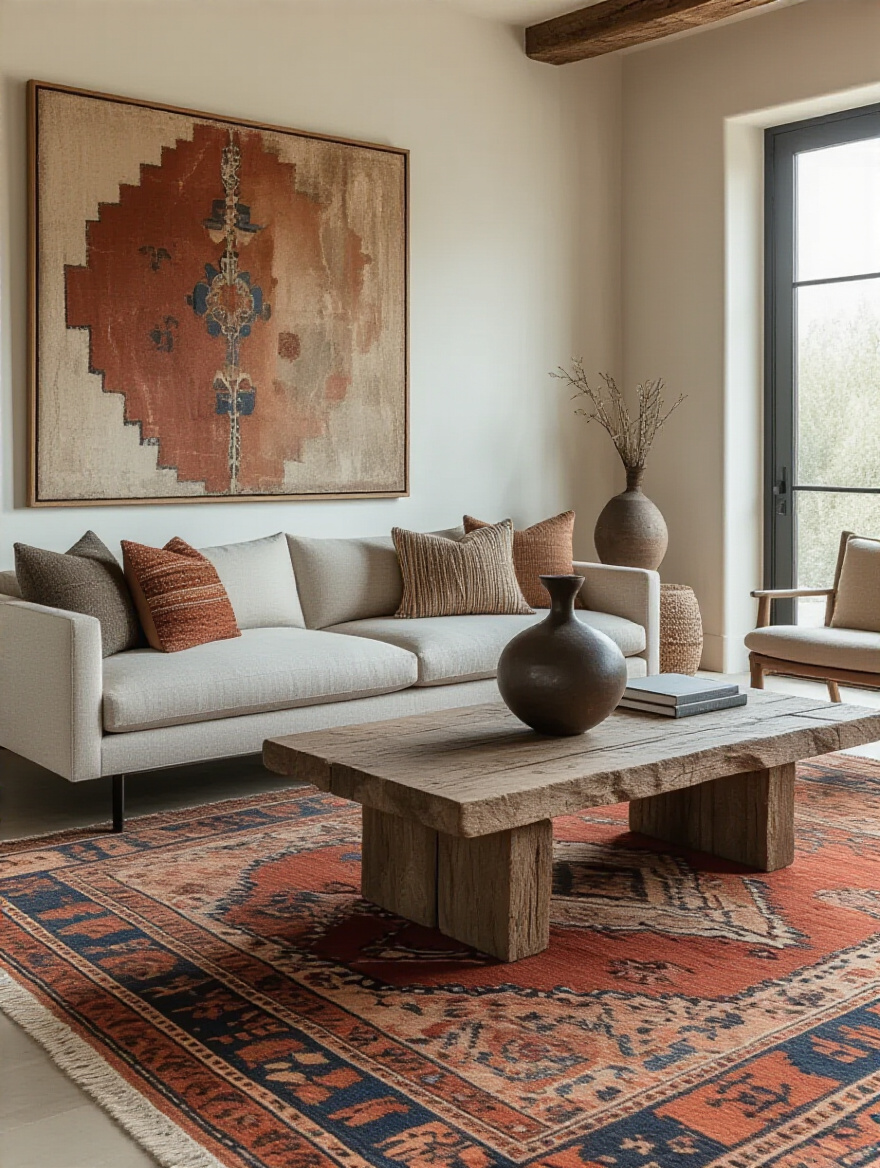
The key to preventing it from looking like a chaotic mess is to find that “curated common thread.” Stick to a unified color palette that ties everything together. Or, repeat a certain material, like warm brass or black metal, throughout the different pieces. It’s this consistency that allows different styles to talk to each other and live happily in the same room.
This next one is the heart and soul of making a house feel like a home.
18. Personalize Your Space with Cherished Mementos and Keepsakes
Your home should be a scrapbook of your life. This goes beyond just arranging decorative objects; it’s about proudly displaying the things that hold real meaning for you. Frame that menu from an anniversary dinner, display the seashell your child found on the beach, hang your grandmother’s vintage scarf as art. These are the things that make your home a one-of-a-kind sanctuary.
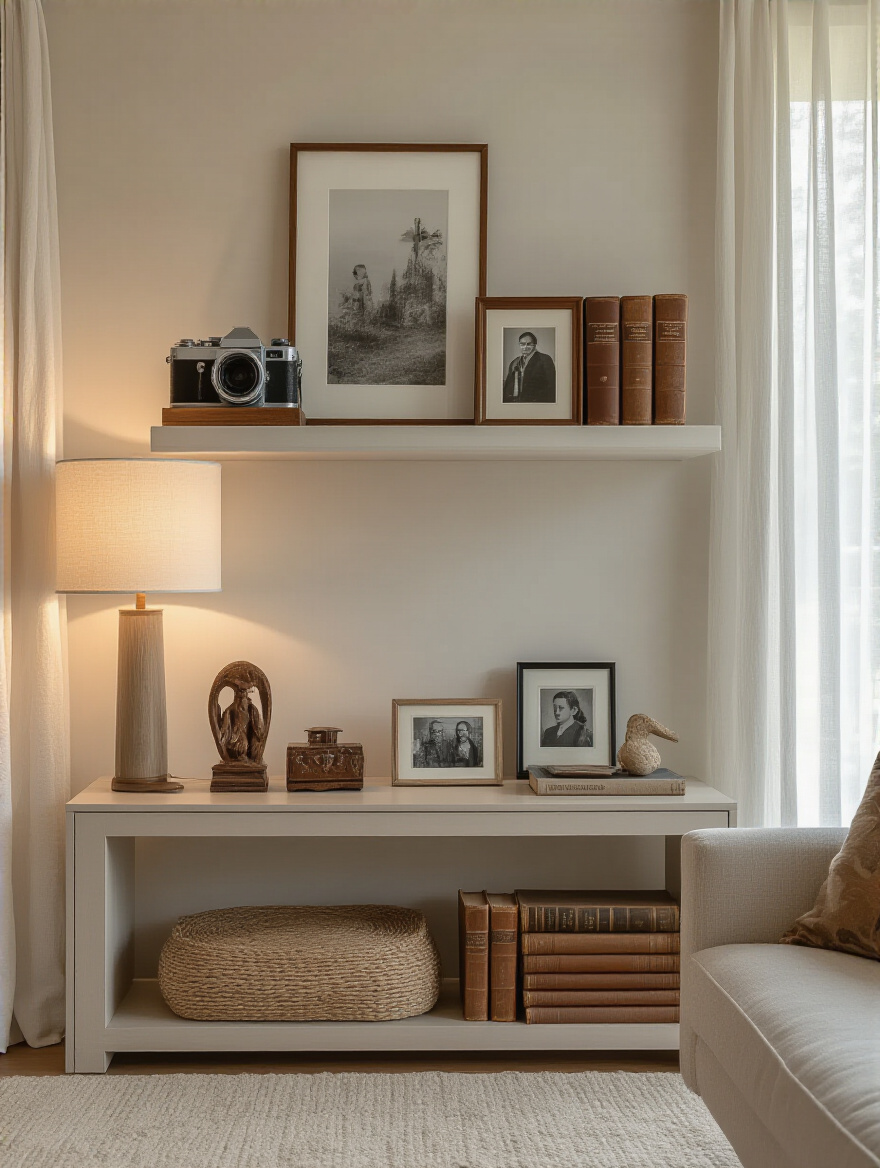
Don’t hide your memories away in a box. Weave them into your decor. A floating shelf dedicated to objects from your travels or a gallery wall filled with family photos through the years infuses your room with love and history. This is the stuff that sparks conversations and gives your home an emotional warmth that you could never, ever buy in a store.
A beautiful room is useless if it’s not comfortable and functional for the people in it.
19. Optimize Seating Arrangements for Conversation and Comfort
Have you ever been in a living room where you had to shout across a vast expanse to talk to the person on the other sofa? It’s the worst. The whole point of a living room is to live in it together. Arrange your furniture to encourage connection. Pull the seating away from the walls and create intimate conversation zones.
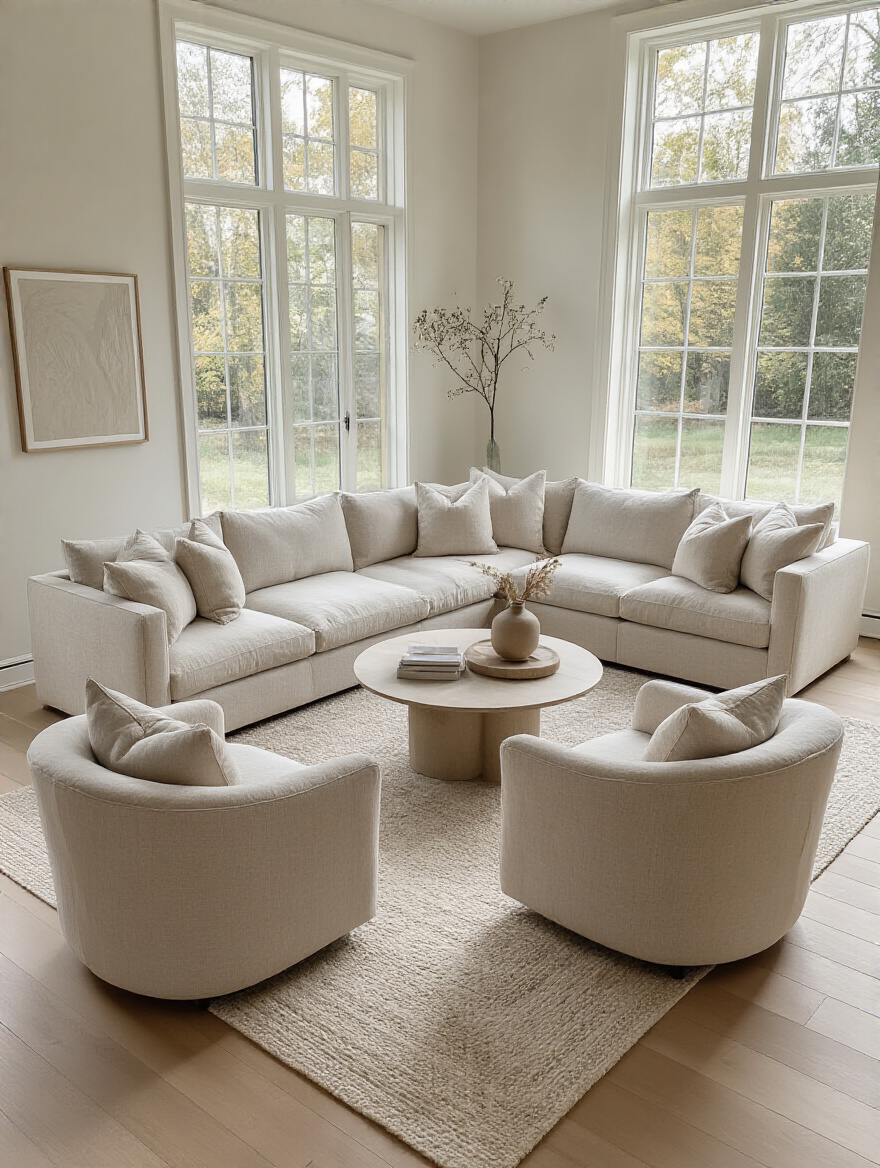
A good rule of thumb is to place chairs and sofas no more than eight feet apart to allow for conversation at a normal volume. Make sure every single seat has a surface nearby—a side table or a coffee table—to place a drink or a book. It’s a small detail that makes a huge difference in how comfortable and welcoming your room feels for both you and your guests.
Finally, let’s tie this all together with the core philosophy: a home that evolves.
20. Plan for Seasonal Decor Swaps to Keep Your Space Fresh
This is the grand finale that makes all the other steps worthwhile! Planning for seasonal swaps is what will keep you in love with your home year after year. It’s about building a small “capsule collection” of decor for each season that you can easily rotate. It’s not about buying a whole new set of decorations every year!
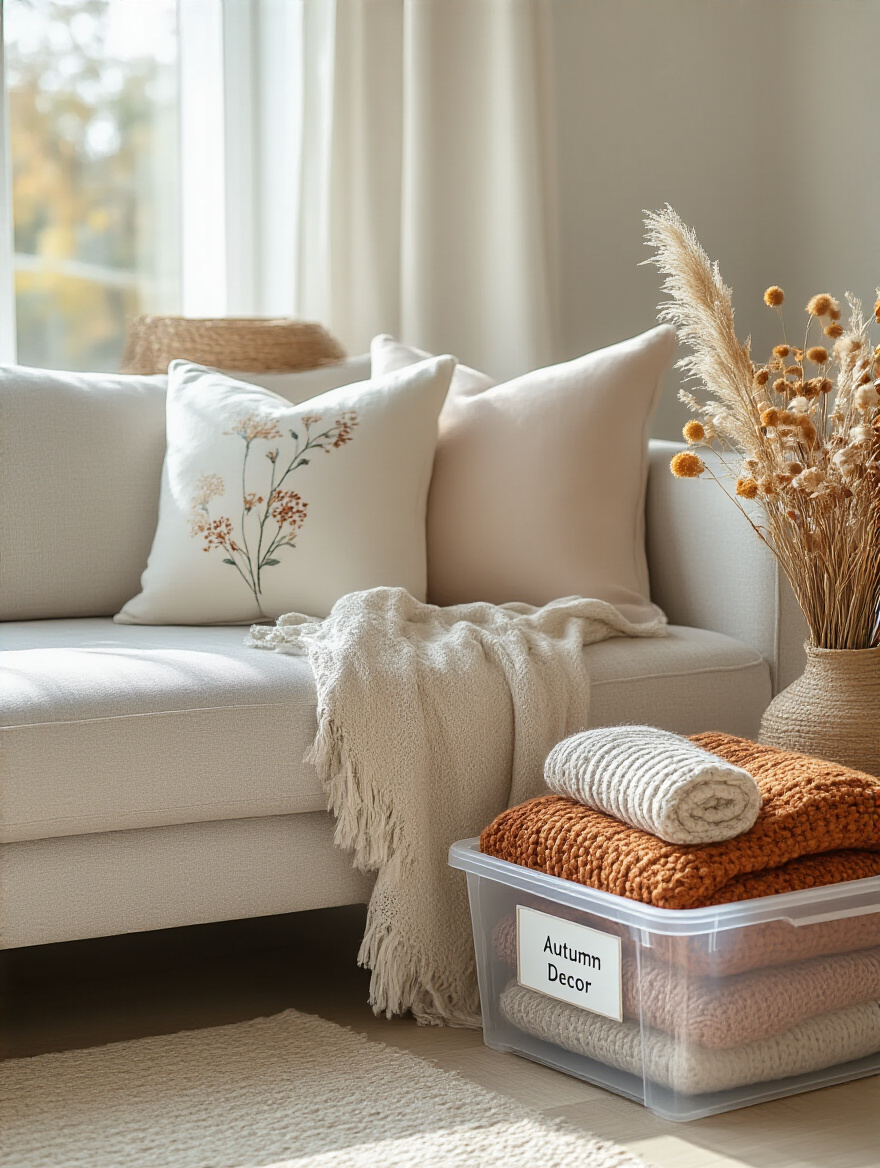
Establish a go-to storage spot for your off-season items. Then, focus on the easy, high-impact swaps: the pillows, the throws, the scent of the candle, the branches in the vase, and maybe one or two art prints on your gallery wall. This simple ritual of ushering in the new season keeps your space feeling dynamic and in tune with the world outside, turning your home into a continuous, joyful celebration of the year.
Conclusion
There you have it—20 ideas to take your living room from a static space to a vibrant, evolving heart of your home. It’s not about achieving some impossible standard of perfection. It’s about creating a space that serves you, tells your story, and brings you joy every single day. The most beautiful homes are the ones that are lived in, loved, and allowed to change.
Don’t feel like you have to do everything at once. The best transformations happen over time. Pick one thing from this list that excites you the most. Maybe it’s just buying a few new pillows or finally hanging that mirror that’s been leaning against the wall. Start there. Play, experiment, and have fun with it. Your home is your canvas—now go create something that feels like you.
